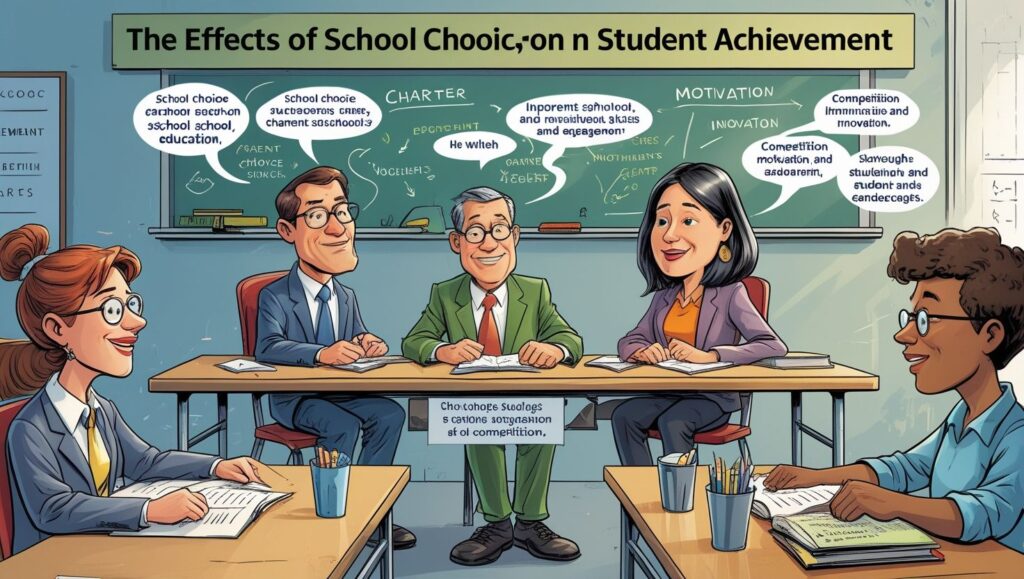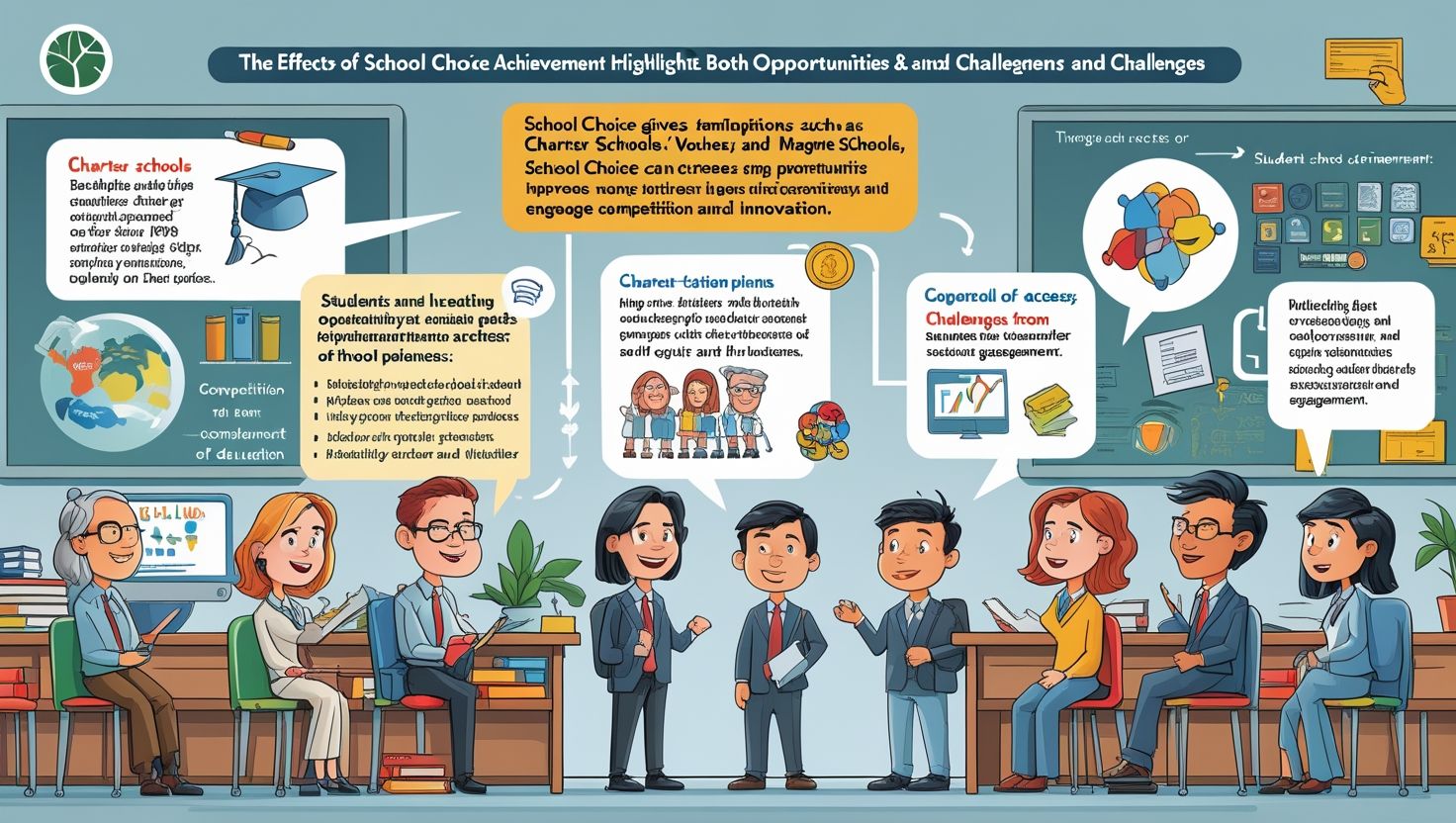Introduction
The Effects of School Choice on Student Achievement, School choice has become one of the most debated topics in modern education. It refers to policies that allow families to select schools outside their assigned districts, including charter schools, private schools, magnet schools, and homeschooling. Supporters argue that school choice empowers parents, improves competition among schools, and leads to better outcomes for students. On the other hand, critics raise concerns about inequality, public school funding, and long-term consequences for communities. Because education directly influences social mobility, the issue of school choice has significant implications for student achievement.
Furthermore, the availability of different options can reshape how students experience learning. Therefore, understanding the effects of school choice is essential for educators, policymakers, and parents. This article explores how school choice impacts academic performance, equity, engagement, motivation, and the overall educational landscape. Through a balanced analysis, the discussion highlights both the benefits and challenges associated with this policy approach.
Defining School Choice and Its Models
School choice policies present families with alternatives beyond their local public schools. The most common forms include charter schools, voucher programs, magnet schools, private school scholarships, and open enrollment policies. Charter schools operate independently but remain publicly funded, while voucher systems provide families with government funds to attend private schools. Magnet schools often focus on specialized subjects, such as science, arts, or technology, and attract diverse students.
Homeschooling has also become part of the conversation, offering families complete control over the learning environment. Each model is designed to create opportunities for improved achievement and personalized learning. However, they vary in accessibility and effectiveness. Consequently, parents must carefully evaluate which model aligns with their child’s needs. Moreover, policymakers must consider the potential impact of these models on public school systems. Understanding the available options allows stakeholders to make informed choices. Therefore, definitions and structures are essential for evaluating school choice outcomes.
Academic Achievement and Competition
One of the strongest arguments for school choice is its potential to improve academic achievement. Supporters claim that when families have multiple options, schools compete to deliver better instruction, curriculum, and services. This competition may encourage innovation, stronger teaching practices, and accountability. Additionally, research shows that students in high-performing charter and magnet schools often outperform their peers in traditional public schools. However, the benefits are not universal, as results differ depending on location, management, and resources. Some studies reveal only modest or mixed improvements in test scores.
Furthermore, the effect may be short-term if schools lack sustainable support. Despite these limitations, the competition created by school choice policies can push schools to raise standards. Yet, critics argue that increased competition may harm struggling public schools. Therefore, while evidence suggests potential academic gains, the overall impact of competition depends on how effectively resources are distributed across all schools.

Equity and Access Concerns
Although school choice expands opportunities, it also raises questions about equity. Families from higher-income backgrounds often have better access to information, transportation, and resources needed to take advantage of alternative options. Consequently, disadvantaged families may struggle to benefit equally. Additionally, voucher programs and charter schools sometimes face criticism for excluding students with differnt needs or language barriers. Moreover, public schools may experience declining enrollment, leading to reduced funding and fewer resources for the students who remain. This widening gap can reinforce existing inequalities in education.
However, advocates argue that school choice can provide underserved students with a chance to escape failing schools. Some charter and magnet schools specifically target low-income communities to address these disparities. Therefore, the issue of equity remains complex and highly context-dependent. Ultimately, ensuring equal access requires thoughtful policy design that supports disadvantaged students, prevents segregation, and guarantees fair distribution of resources across all schools.
Parental Involvement and Motivation
School choice often increases parental involvement in education. When parents actively select a school, they tend to feel more responsible for their child’s progress. This involvement may include frequent communication with teachers, participation in school activities, and supporting learning at home. Furthermore, research suggests that when parents believe they have chosen the best option, they develop higher expectations for their children’s success. These expectations, in turn, may boost student motivation. Moreover, schools that rely on enrollment competition often encourage stronger parent engagement to maintain satisfaction and retention.
However, challenges also exist. Parents may lack adequate information about school quality, relying on reputation rather than evidence-based performance data. Additionally, not all families have equal time or resources to participate actively. Despite these barriers, school choice has generally been associated with higher levels of parental involvement. Therefore, improved motivation and engagement are considered significant indirect effects of school choice policies.
Student Engagement and Learning Environments
Another effect of school choice on student achievement relates to engagement and the learning environment. Specialized programs in charter or magnet schools often provide unique opportunities tailored to student interests, such as arts, science, or technology. When students enroll in schools that match their strengths or passions, they are more likely to stay motivated and engaged. Furthermore, smaller class sizes and innovative teaching practices in some choice-based schools can create more personalized experiences. These factors contribute to higher levels of satisfaction and better academic outcomes. However, engagement levels are not always consistent.
For example, poorly managed schools may struggle to maintain quality, leading to disillusionment among students. In addition, frequent transfers caused by dissatisfaction or logistical challenges may disrupt learning continuity. Nonetheless, when schools successfully align student needs with curriculum and teaching styles, engagement improves. Therefore, the link between school choice and student engagement significantly influences overall achievement outcomes.

Long-Term Outcomes of School Choice
The long-term effects of school choice on student achievement remain a subject of ongoing research. Some studies suggest that students who attend high-quality charter or private schools are more likely to graduate and pursue higher education. In addition, exposure to rigorous academic environments may develop resilience and independence. However, other research indicates that outcomes vary depending on family background, school management, and available resources.
Furthermore, critics argue that the benefits of school choice are often overstated, with minimal differences compared to traditional public schools. Nevertheless, the potential to provide a better academic foundation cannot be ignored. Beyond academics, school choice can also shape values, social networks, and future career paths. Therefore, while long-term results differ, school choice policies continue to play an influential role in shaping student trajectories. Ultimately, their effectiveness depends on ensuring equitable access, high-quality standards, and sustainable support systems for all schools.
Policy Implications and Future Directions
The effects of school choice on student achievement carry important policy implications. Governments must balance the benefits of competition and innovation with the need to protect public schools. Policies that support accountability, transparency, and equitable funding are essential. Additionally, policymakers should ensure that disadvantaged families can access school choice opportunities without facing barriers. Transportation assistance, clear performance data, and fair enrollment practices can help achieve this goal.
Moreover, continuous evaluation of charter, voucher, and magnet programs is necessary to assess their effectiveness. Without proper oversight, some schools may exploit funding or fail to deliver promised results. Furthermore, collaboration between traditional and choice-based schools can encourage the sharing of best practices. The future of school choice depends on striking a balance between freedom and fairness. Therefore, policymakers must adopt inclusive strategies that prioritize student achievement while maintaining equity across the entire education system.
Conclusion
School choice has undeniably reshaped the educational landscape by offering families greater flexibility and encouraging schools to improve. It has shown potential benefits in enhancing academic performance, increasing parental involvement, and creating engaging learning environments. However, it also presents challenges, particularly in terms of equity, access, and long-term consistency. While some students thrive under school choice policies, others may face barriers that limit their opportunities. The impact on public school systems also raises important concerns about funding and fairness. Consequently, the effects of school choice on student achievement are both positive and complex.
Future success depends on designing policies that balance innovation with inclusivity, ensuring that all students have equal opportunities to succeed. Therefore, continued research, careful planning, and responsible implementation are vital. Ultimately, the goal should remain clear: to provide every student with the best possible education, regardless of background or school type.
References
- Chingos, M. M., & Whitehurst, G. J. (2012). Choosing blind: School choice without transparency. Brookings Institution.
- Lubienski, C., & Lubienski, S. T. (2006). Charter, private, public schools and academic achievement: New evidence from NAEP mathematics data. National Center For The Study Of Privatization In Education.
- Berends, M., & Zottola, G. (2009). Social perspectives on school choice. Annual Review of Sociology, 35(1), 151–168.
- Rouse, C. E., & Barrow, L. (2009). School vouchers and student achievement: Recent evidence and remaining questions. Annual Review of Economics, 1(1), 17–42.
- Carnoy, M. (2017). School vouchers are not a proven strategy for improving student achievement. Economic Policy Institute.
